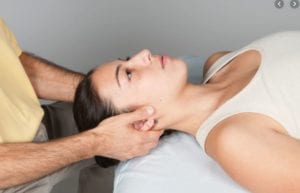Cervical traction is a form of decompression therapy that reduces pressure on the spine. It can be performed manually or mechanically to treat various spinal pathologies. This article explains several benefits and risks associated with this technique, and shares the opinion of a physiotherapist on its relevance for relieving neck pain.
Definition and benefits
Cervical traction refers to stretching the cervical region to enlarge the space between the vertebrae and spinal joints. The targeted therapeutic effects are as follows:
- pain relief
- better spinal alignment
- stimulate blood circulation
- reduce compressive forces on the spine
- release pressure on nerves
- reduction of paresthesias (numbness, tingling, etc.) in the upper limb
- disc decompression
- muscle stretching
- improvement in function
- avoid the use of medications, infiltrations or surgeries
Note: Certain therapeutic virtues conveyed by therapists or sellers of traction devices are devoid of scientific evidence, and remain to be demonstrated by studies.
Indications
People with neck pain or other neck problems cervical spine can benefit from this form of therapy. Cervical and spinal traction is regularly used by healthcare professionals for the following conditions:
- herniated disc et cervical hernia
- zygapophyseal osteoarthritis
- cervical spondylosis
- degenerative disc disease
- cervico brachial neuralgia
- narrow cervical canal
- radiculopathy cervical
- spondylolysis et spondylolisthesis
Risks and contraindications
Although often effective in relieving pain, cervical traction can sometimes make symptoms worse. Likewise, the body sometimes reacts to pull-ups by causing muscle spasms, especially if the techniques are aggressive and unpredictable. Other symptoms observed may be headaches, visual disturbances, nausea or dizziness.
Thus, certain conditions constitute precautions (even contraindications) to spinal traction. We think, for example, of osteopenia, some forms of arthritis, infection, cervical vascular disease, osteoporosis, some cancers with bone metastases, or any damage to the spinal cord. Traction should also be avoided immediately after surgery involving the cervical region, or in the presence of cervical instability.
Finally, cervical traction must be adapted in the acute phase (for example after a whiplash). Indeed, the traction will have the effect of stretching the cervical structures such as muscles or ligaments. If they are inflamed or irritated by the trauma, the patient might feel more pain instead of relief.
If cervical traction causes an increase in symptoms, it will be important to communicate the information to your healthcare professional. This one to adjust the parameters of the traction, or stop administering it altogether to focus on another treatment approach.
Procedure
Cervical traction can be administered manually or mechanically, depending on the patient's condition and the therapist's preference.
Manual cervical traction
In the case of manual traction, the healthcare professional (often a physiotherapist, physiotherapist, osteopath or chiropractor) uses their hands to perform the technique. It exerts manual force aimed at enlarging the space between the vertebrae and spinal joints.
It should be noted that pull-ups can be applied according to various parameters. One can adjust the intensity of the traction (referred to as grades in manual therapy) to have to have the desired therapeutic effect. Similarly, vibratory movements can be performed to modulate the pain and provide a relaxation effect. Finally, cervical traction can be performed just before a joint manipulation to prepare the neck for a crack.
Mechanical cervical traction
Cervical traction can also be done using adapted tools or devices. We then speak of mechanical traction.
Although cervical traction performed by professionals is the safest method, there are nevertheless interesting products that can help relieve pain using the same principle.
The cervical hammock provides similar benefits. This is a hammock specially designed to relieve neck pain. The traction produced by the device will decompress the vertebrae and stretch the muscles and ligaments.
You can use this device in addition to sessions with a professional, or when you feel the need. The advantage of such an accessory is that you can take it almost anywhere and use it much more frequently. It thus makes it possible to avoid or reduce the use of analgesics.
If using a neck hammock causes an increase in symptoms, please stop the activity and seek advice from a healthcare professional.
Use :
It is enough to hang the hammock on a fixed support. You can hang it on a door handle (see image), a wall hook or a pull-up bar for example. It is enough for you to adjust the height of the hammock so that it is positioned a few centimeters above the ground.
Do not hesitate to vary the height and the distance in order to find the parameters that relieve you the most. Be careful, however, of do not strain the muscles too much your neck to avoid making symptoms worse.
Traction can be held for an extended period, or held for short periods (between 10-20 seconds) repeatedly. One can also apply cervical traction several times a day to relieve its symptoms.
Opinion of the physiotherapist
If performed by an expert, neck traction can greatly relieve symptoms and improve quality of life. As a physiotherapist (physiotherapist), I use them regularly in the practice to treat the neck pain of many patients.
The problem is that some medical professionals convey the message that tractions will correct disc problems "by returning the disc to its original position". This theory has not been scientifically proven, and it is not correct to assume that cervical traction will correct his herniated disc, disc protrustion or other disc pathology.
Similarly, pull-ups most often provide a short-term effect only. Certainly, this creates an optimal environment for healing, but other approaches must be integrated to obtain lasting relief. Currently, studies show that progressive and adapted therapeutic exercises not only reduce long-term pain, but also prevent recurrences and improve function.
In summary, cervical tractions are beneficial for treating many conditions, but they must be integrated within a global approach taking into consideration all the facets of the person who contribute to the pain (physical, psychological, emotional, etc.) .
References
- https://www.healthline.com/health/spinal-traction
- https://www.webmd.com/pain-management/what-to-know-about-neck-traction
- https://www.wellbeing365.com.au/home-cervical-traction/
My name is Anas Boukas and I am a physiotherapist. My mission ? Helping people who are suffering before their pain worsens and becomes chronic. I am also of the opinion that an educated patient greatly increases their chances of recovery. This is why I created Healthforall Group, a network of medical sites, in association with several health professionals.
My journey:
Bachelor's and Master's degrees at the University of Montreal , Physiotherapist for CBI Health,
Physiotherapist for The International Physiotherapy Center


